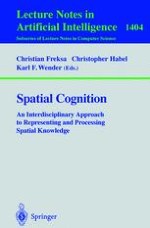
1998 | OriginalPaper | Chapter
Allocentric and Egocentric Spatial Representations: Definitions, Distinctions, and Interconnections
Author : Roberta L. Klatzky
Published in: Spatial Cognition
Publisher: Springer Berlin Heidelberg
Included in: Professional Book Archive
Activate our intelligent search to find suitable subject content or patents.
Select sections of text to find matching patents with Artificial Intelligence. powered by
Select sections of text to find additional relevant content using AI-assisted search. powered by
Although the literatures on human spatial cognition and animal navigation often make distinctions between egocentric and allocentric (also called exocentric or geocentric) representations, the terms have not generally been well defined. This chapter begins by making formal distinctions between three kinds of representations: allocentric locational, egocentric locational, and allocentric heading representations. These distinctions are made in the context of whole-body navigation (as contrasted, e.g., with manipulation). They are made on the basis of primitive parameters specified by each representation, and the representational distinctions are further supported by work on brain mechanisms used for animal navigation. From the assumptions about primitives, further inferences are made as to the kind of information each representation potentially makes available. Empirical studies of how well people compute primitive and derived spatial parameters are briefly reviewed. Finally, the chapter addresses what representations humans may use for processing spatial information during physical and imagined movement, and work on imagined updating of spatial position is used to constrain the connectivity among representations.